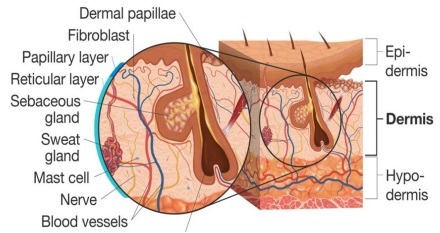Skin and its layer, function
The largest and most complex organ in the body is the skin. The numerous specialised cells and structures that make up the skin are constantly evolving.
Skin
- The largest and most complex organ in the body is the skin. The numerous specialised cells and structures that make up the skin are constantly evolving.
- The skin’s main job is to protect the body from harmful surroundings and microorganisms that cause disease. Additionally, it assists in controlling body temperature and collects sensory data from the environment. Additionally, it actively contributes to the body’s immune reaction to whatever it considers hazardous.
- Skin consists of three main layers:
- Epidermis
- Dermis
- Hypodermis
Epidermis
- The epidermis, which is the skin’s apparent outermost layer, serves as a barrier against external elements like bacteria and viruses, keeping them from penetrating the skin’s deeper layers.
- As it removes the dead skin cells each day, this layer is continuously replenished.
- We obviously remove about 500 million skin cells daily. Additionally, the epidermis’ outermost layers are made up of 25–30 layers of dead cells. It stops the skin from losing water, and the melanocytes that are there give it its colour.
- In addition, there are five additional layers in the epidermis: the stratum Basale, stratum spinosum, stratum granulosum, and stratum corneum.
Dermis
- The second layer of skin, called dermis, is located underneath the epidermis. Collagen, blood arteries, elastin, and hair follicles are all present in this layer. This layer produces sweat because it contains sweat glands that aid in the removal of toxins from the body. The feeling of touch in your body is produced by nerve endings in the dermal layer.
- Sebaceous glands, which are located in this layer, create sebum, a natural oil that keeps the skin moisturised.
- Dermis has two layers:
- Papillary Dermis
- Reticular Dermis

Hypodermis
- Adipose tissue that is loose and well-vascularized as well as connective tissue makes up the hypodermis, or subcutaneous tissue. The deeper tissues that are found below the hypodermis, such as bone, muscle, tendon, ligament, and joint capsule.
- This layer’s primary jobs include holding the dermis to the body, regulating body temperature, and storing fat. This layer serves as a cushion or shock absorber while preserving the warmth. This layer’s fat shields your interior organs, bones, and muscles from harm. The layer also aids in securing the dermis to the muscles and bones.

Function
- It protects against diseases or foreign chemicals. The immune system includes the Langerhans cells found in the skin.
- Water and lipids (fats) are stored there.
- Nerve endings that detect temperature, pressure, movement, contact, and damage can perceive sensation.
- By preventing water from escaping, it restricts water loss.
- It stops the skin’s natural nutrients from being taken away.
- The skin assists in keeping the body cool by causing sweat production and blood vessel dilation.
- Skin is crucial because it keeps the body at the right temperature and shields it from dangerous radiation.

